Maranta leuconeura is one of those houseplants that I’ve had for longer than I can actually remember! Which, of course is a good sign that it’s a plant that has longevity. These plants are easy going, slow growing houseplants — a great choice for smaller spaces. I particularly love the interesting foliage and way that the plant moves its leaves throughout the day.
Today’s post is all about how I care for my Maranta leuconeura and I will be covering the topics of:
- light + positioning
- watering
- humidity + leaf care
- fertilising
- flowering
- pests + treatment
- repotting
- potting mix (+ pots)
- + propagation
INTRODUCING PRAYER PLANTS…
As a brief introduction, Maranta is indeed a prayer plant. Prayer plants are a group of plants that are known as Marantaceae, Maranta being one of the plants in that group. I just wanted to clarify that as it can be a little confusing if you are just getting used to botanical nomenclature! So within this Marantaceae, or Prayer Plant family, other relatives you might have heard of in include Calathea, Stromanthe and Ctenanthe. Most of these are known for their patterned, colourful foliage. The leaves fold and raise up at night, as if in prayer, which makes for an interesting show!
Of this plant gang, I currently own two Stromanthe plants which I propagated by division and one Maranta. I’ve had a few Calathea over the years but they aren’t known for their longevity, which is more my preference these days. I had a Calathea Orbifolia which did (surprisingly) well for a few years but it hated being moved last year and never quite recovered.
The thing about the more tricky plants from this group is that they can tend to put you off if you have a challenging experience with them. Personally, I would recommend a Maranta or a Stromanthe over a Ctenanthe or Calathea any day of the week. They are just a bit more easy going. Way better as an introduction to growing prayer plants I think!

MARANTA LEUCONEURA VARIETIES
The plant you’ll see throughout the post is my own. I’ll be calling it Maranta leuconeura throughout, but for clarity, it’s ‘full’ name is actually a bit of a mouthful! It’s a Maranta leuconeura var. kerchoveana. Also known as ‘rabbit tracks’ Maranta. It’s has blue-green foliage with dark brown splotches. The other popular type of Maranta leuconeura is the red-backed herringbone Maranta. This is Maranta leuconeura erythroneura. The care requirements are the same for both plants.
I’ll pop a photo below for comparison:


LIGHT
One of the best things about Maranta leuconeura is just how adaptable they are in terms of their lighting needs. They aren’t fussy. I’ve actually grown mine in a variety of conditions in my last three homes. The main consideration though is that they certainly prefer a position out of direct light, which tends to suit a typical home environment well. That translates as fairly bright, indirect light and I’m in the northern hemisphere for reference. The leaves are paper-like to the touch which indicates their sensitivity to very bright light. This will likely result in scorching — thicker foliage is much more robust and resilient to strong light.
Maranta can do well for many years in a shaded position, whereas some of the other prayer plants are a bit more demanding or have a tendency to lose their variegation in dark rooms, like a Stromanthe triostar. This is perhaps why you commonly see the herringbone Maranta (with the red undersides) in libraries, malls and foyer planting displays. These environments are largely lit by artificial light too. My rabbit tracks maranta you see here in the post is perhaps less common. But I’m drawn to blue-toned green foliage… So this one is my preferred choice if I had to pick!


POSITIONING
First of all, my plant was in a South-West facing room around 3 metres from a window, with the light filtered by a net. This really helped to prevent the foliage from looking washed out or crispy as a result of a light that was too intense. That was in my old apartment in Wales. Next, my Maranta leuconeura moved to North Yorkshire with me and sat on top of my fridge in the cottage I was in for 18 months. This was a North-West facing space which had some trees outside which certainly had an impact on softening the light. Here in the Chapel it’s a few metres away from my east window which is softer and gets the sun in the morning. It’s been enjoying this for the couple of months I’ve been here.
If your plant is placed against a wall with light coming from one direction, it will be helpful to rotate your plant every few weeks to ensure that all the plant is getting good light exposure. Parts of the pot that are shrouded by the other foliage as the Maranta matures can die back if they don’t receive enough light.


Bear in mind that these are the conditions that are personal to my current environment and are used as a guide for you to compare with your own home. It’s important to also remember that windows can be pretty different in size and if you live in a built up area, with other buildings close by, or if there are obstacles like trees outside as I mention above, this all has an impact on the intensity of light.

WATERING
Of all the prayer plants, I’ve found my Maranta leuconeura to be the most forgiving if I forget to water it now and again. Generally though, consistency can really help to keep these plants growing well. Prayer plants prefer to have their potting mix at a consistent moisture but that doesn’t mean too much water all the time. A Maranta hates to dry out completely. The leaves might develop markings on them and curl inwards, plus the tips of the foliage might also crisp in protest too.
A hygrometer is a useful bit of kit I wouldn’t be without and one I would recommend if you struggle to get houseplant watering right. I also like to use a watering spike with my prayer plants to help bridge the gap between waterings. Here are some clear ones or there’s a colourful option here.
Remember that tepid (room temperature) water is always best for your houseplants – anything too cold can shock them. Maranta are quite sensitive to tap water too. If you live in an area with hard water like me, you might notice some marks on the leaves (these can be wiped away with a soft cloth). If possible, using rain water or filtered water can help to prevent some brown crisping at the leaf edges too. When the outside space is levelled here on the renovation, I’m going to be installing a water butt ASAP! I think my houseplants are going to enjoy that…
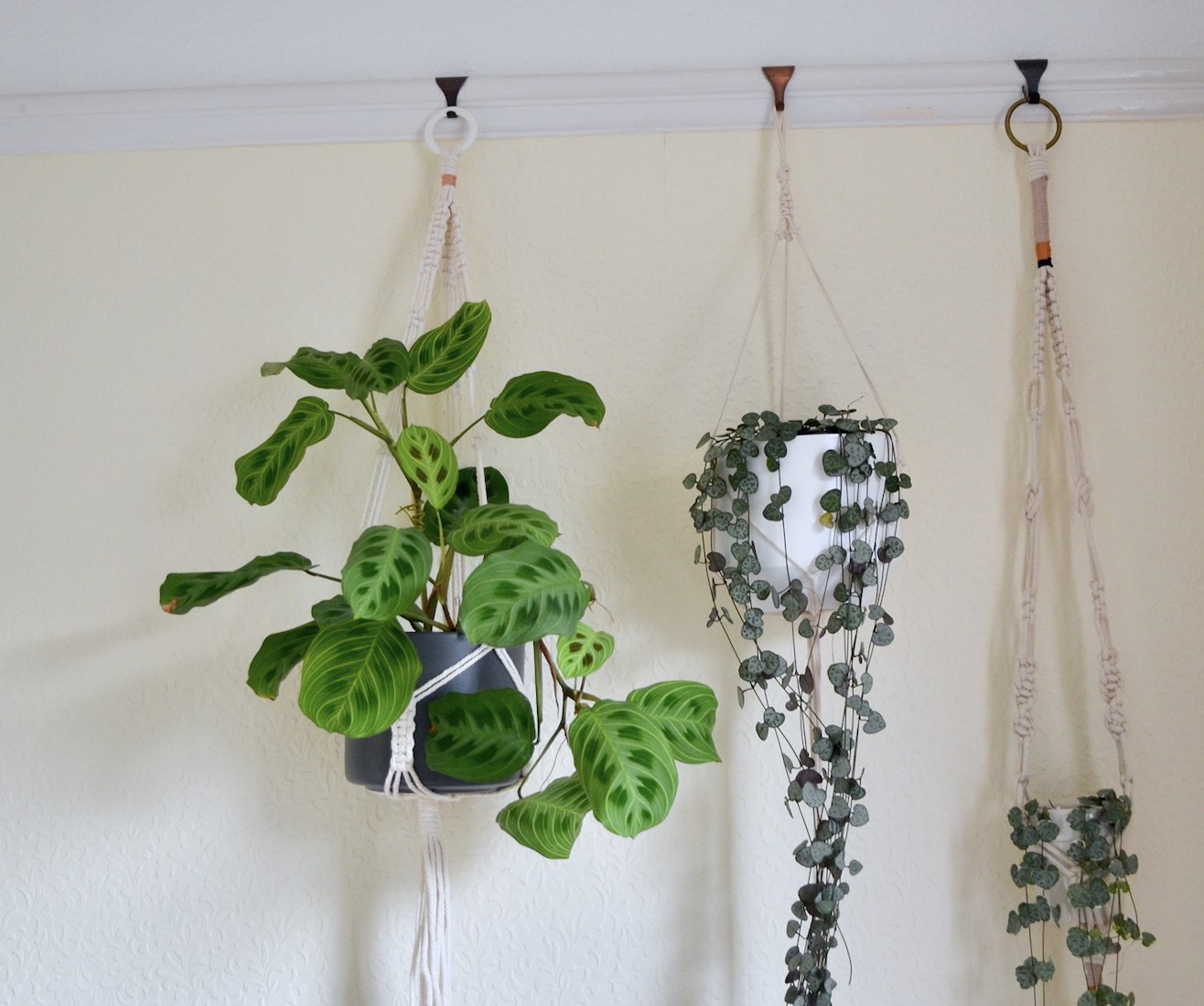
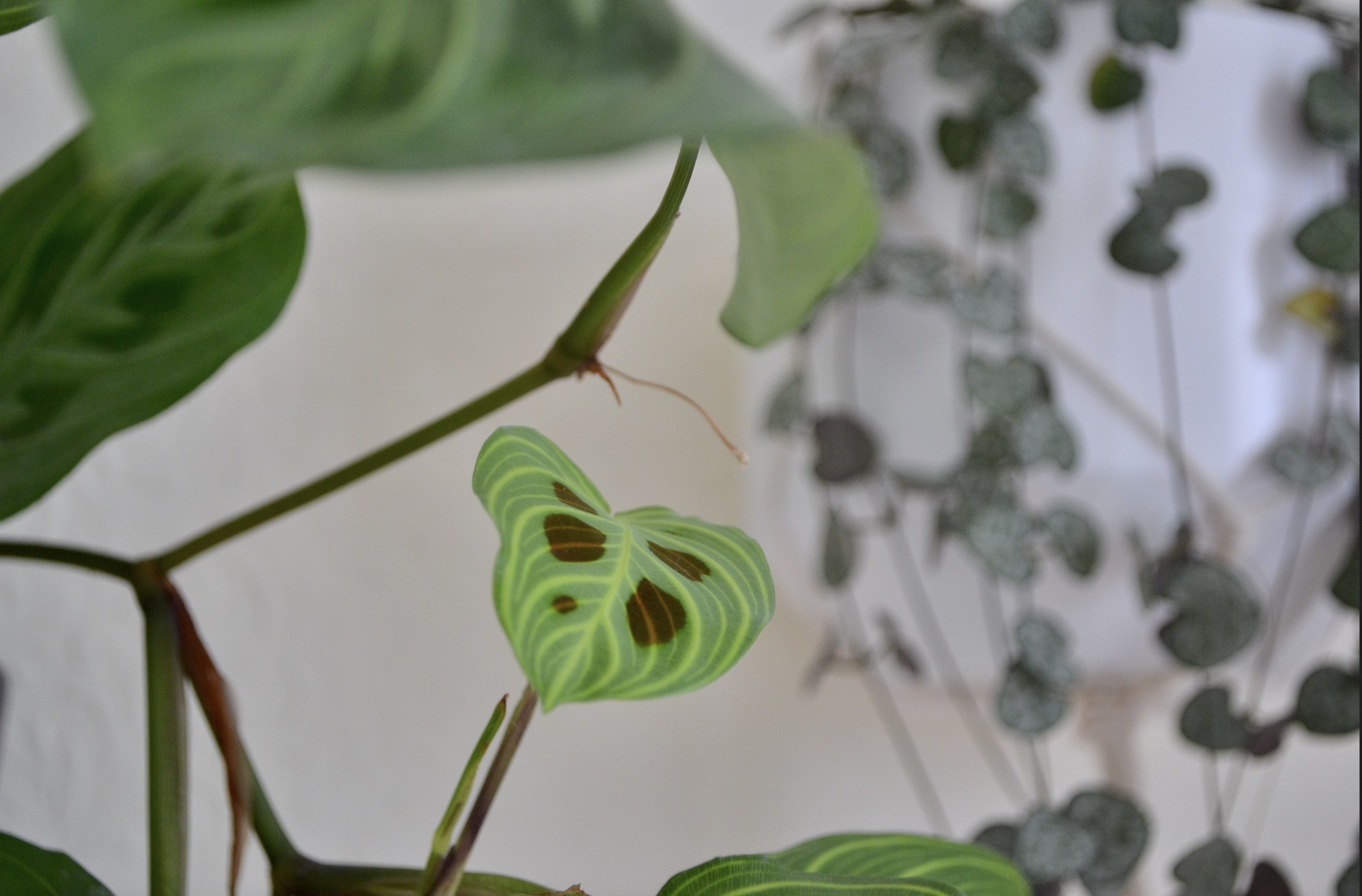
HUMIDITY
Compared to other prayer plants, the Maranta leuconeura grows very well in typical household humidities. This is what makes it such a forgiving houseplant I think. As much as increasing humidities with humidifiers etc. can really help your plants to thrive, it doesn’t suit all environments. If you do grow tropical plants though, higher humidities can really ramp up growth and leaf size. My home conditions are really different compared to what I’ve been used to over the last 8 years so my plants and I are currently adapting!
One thing to note here though, try to resist placing a Maranta close to heaters, draughts or air conditioning units because these plants really dislike temperature fluctuations. You’ll likely also get crisping on the foliage in these locations where the air is notoriously dry.
Another way to create favourable conditions around your plant is to top your pot with Sphagnum moss. This can help conserve moisture levels which can reduce watering frequency. It can also create a very slight increase in localised humidity. At the bottom of my pot (underneath my drip tray), I have an inch or two of pebbles that lifts the pot and tray up in the planter. When it’s really warm, I will occasionally add some water to this, which lets the moisture evaporate around the foliage. But this is more a practical styling thing than an effective way to raise humidity, as the results are only negligible and temporary. Understanding the relation between watering balance and potting mix is the best way to keep your Maranta happy.
LEAF CARE
To keep your plants looking their best, keeping foliage free from dust is an intrinsic part of houseplant care. I can safely say I’ve never struggled with this as much as right now — renovation dust is the bane of my life! My Maranta leuconeura doesn’t get quite as dusty in comparison to some of my larger-leaved houseplants like my Monstera and Ficus family. But still. The dust gets everywhere!
As you can see in the photographs in this post, Maranta leaves are lovely and soft and have an interesting texture. They remind me of a slightly less velvety version of Calathea warscewiczii foliage in a way. Due to this texture, the water beads up on the leaves when they get wet. When things are looking a little lacklustre and I notice a veil of dust beginning to settle on the leaves, I’ll give my plant a clean in the shower. When cleaning, don’t forget about the undersides of the leaves. This is also a good time to check for pests. I’ve got a more comprehensive post on my leaf cleaning technique which I’ll link to here if you want to see more tips.

FERTILISING
My Maranta leuconeura is very laid back when it comes to requiring regular fertilising. I generally feed my plant around once or twice a month when the plant is actively growing. I use a balanced liquid houseplant fertiliser at half the recommended dilution rate. Before feeding, check to ensure the potting mix isn’t excessively dry — this can prevent fertiliser burn. As it’s not good to let your Maranta dry out between waterings though, it’s rarely a problem. But it’s something to be aware of if the weather has been hot.
In terms of when to feed, the easiest way to judge is if your plant is showing signs of growth. It’s very cold where I live during Winter and with the harsh decrease in temperatures, I’ve been getting used to my houseplants stopping growing altogether. During their rest period, I stop feeding until I notice signs of active growth resuming. If your climate is quite different to mine and you find your plants grow year-round, then more regular fertilising is absolutely fine.
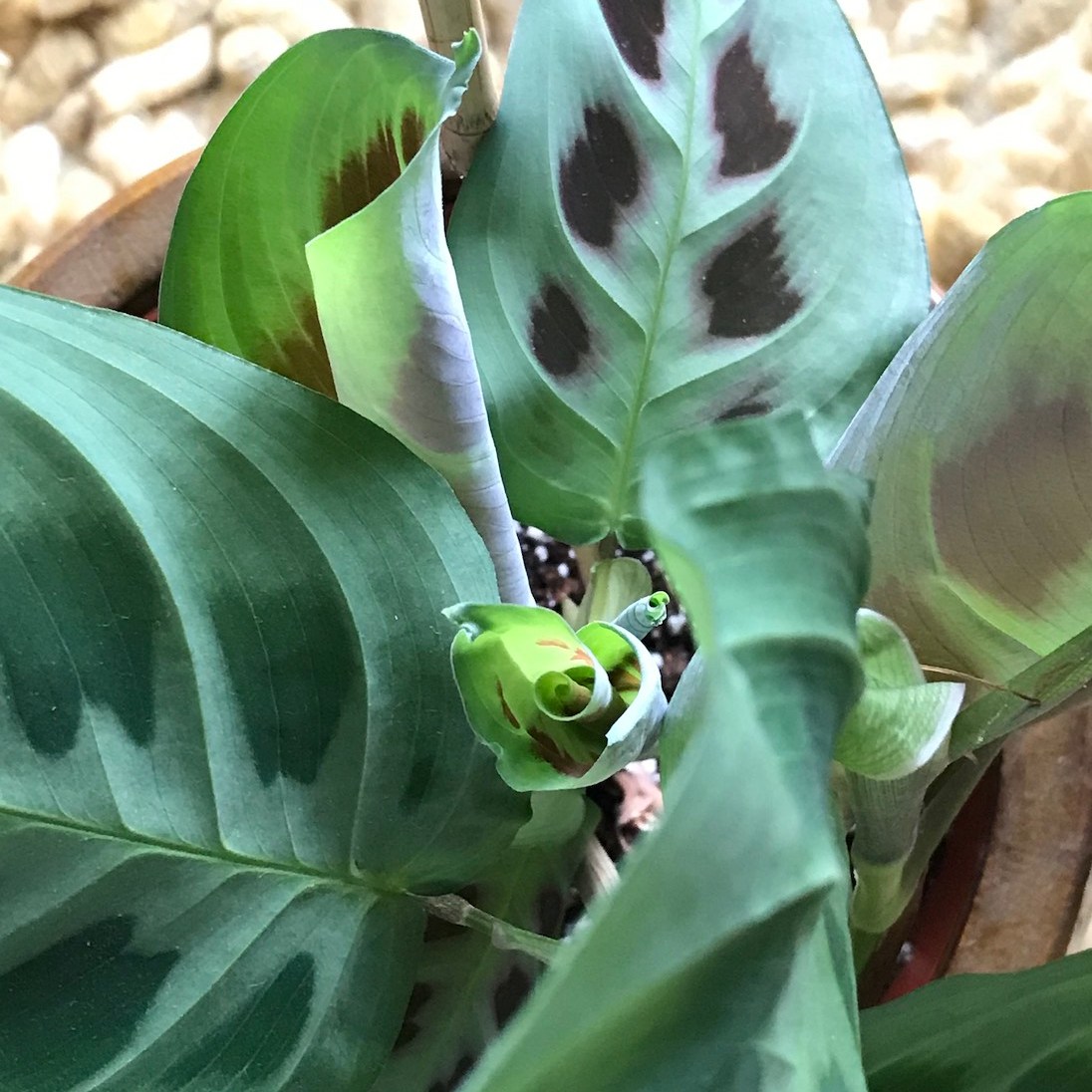

FLOWERING
My Maranta flowers around once a year as it’s matured a bit. The flowers are small and white and very pretty! Typically, I can’t find a photo as I’m writing this post, but if I do I’ll insert one later. These plants are mainly grown for their foliage and not their flowers though.
PESTS
Prayer plants in general have a bit of a bad reputation for pests. This is because the more tricky plants like Calathea can be susceptible to things like Spider mites, mealy bugs etc. By comparison, I find Maranta to be more robust in resisting pest pressures. This of course is directly related to establishing a good care regimen, and understanding the needs of the plant(s) in question.
Think about the points we have considered so far in this care guide as a start. Ensure your Maranta is getting suitable light, keep a consistency with your watering routine and clean the foliage to prevent dust build up. Regular cleaning is a good pest deterrent, particularly in high traffic areas where dust can build up more quickly.


Above and below: Maranta foliage is much easier to keep clean than a Stromanthe (below) as the mid-rib of the leaves are much less pronounced on a Maranta. This is where dust or pests can congregate, and I find I have to be much more vigilant with my Stromathe than with my Maranta leuconeura.


As a Maranta prefers a softer, indirect light, it’s less likely to be affected by the harsh environmental conditions that can exacerbate any lurking pest problems. Whilst Maranta cope well in typical household humidities, be mindful if your home is very dry as this could be problematic in the long term. Pest pressures are often compounded by low humidities and dry, bright conditions. This can can cause an attack of red spider mite, thrips or mealy bugs. Mealy bugs tend to congregate around where the multiple stems form into clumps at soil level.
TREATMENT
There are a number of ways to deal with pests but the last time I had a slight problem with my Stromanthe I gave it a castille solution spray and bath — roots and all — before showering down. It’s messy but it did the job! See photo below. I’ve not done this with my Maranta, but you will need to be more gentle as the leaves are that much more delicate. I would say a treatment spray would be my first port of call with this one.

After any treatment, I like to use SB plant invigorator either as a ready to use spray, or you can also get a concentrated bottle to dilute into a spray bottle yourself. Again, you will need to test a part of the plant first. I spray the front and back of the foliage as some extra post-treatment care, but be careful to keep out of direct light as the leaves will be more sensitive after any pest treatment.
I’ve also used a neem oil solution which is also very effective for something more widespread, or if it’s something very minor, a Q-tip dipped in rubbing alcohol works too. When I’ve had a pest issue with my plant, I always isolate it for a number of weeks before reintroducing near my other plants. If you discover a pest issue, it’s always best to carry out a thorough check of any plants that were located nearby, or any plants that are generally more sensitive to an attack.
MARANTA LEUCONEURA REPOTTING
As a slower growing houseplant, Maranta leuconeura doesn’t require frequent repotting. A new planter one size bigger than the previous one every 12-24 months is usually absolutely fine. When you are planning to re-pot, it’s good practice to water your plant a few days in advance of the task. This is because manipulating a very dry plant can sometimes cause transplant shock. Remove the plant from the pot and be gentle with the roots as you loosen them with your hands, shaking off any old potting mix. Despite not needing repotting often, these plants will really benefit from new potting mix when they are repotted.
I tend to do my repotting in batches so will make up a container of potting mix that suits the plants in question. Remember to check whether or not your compost has any slow release fertiliser in it, so that you aren’t double feeding. As I said above, Maranta really dislike this!
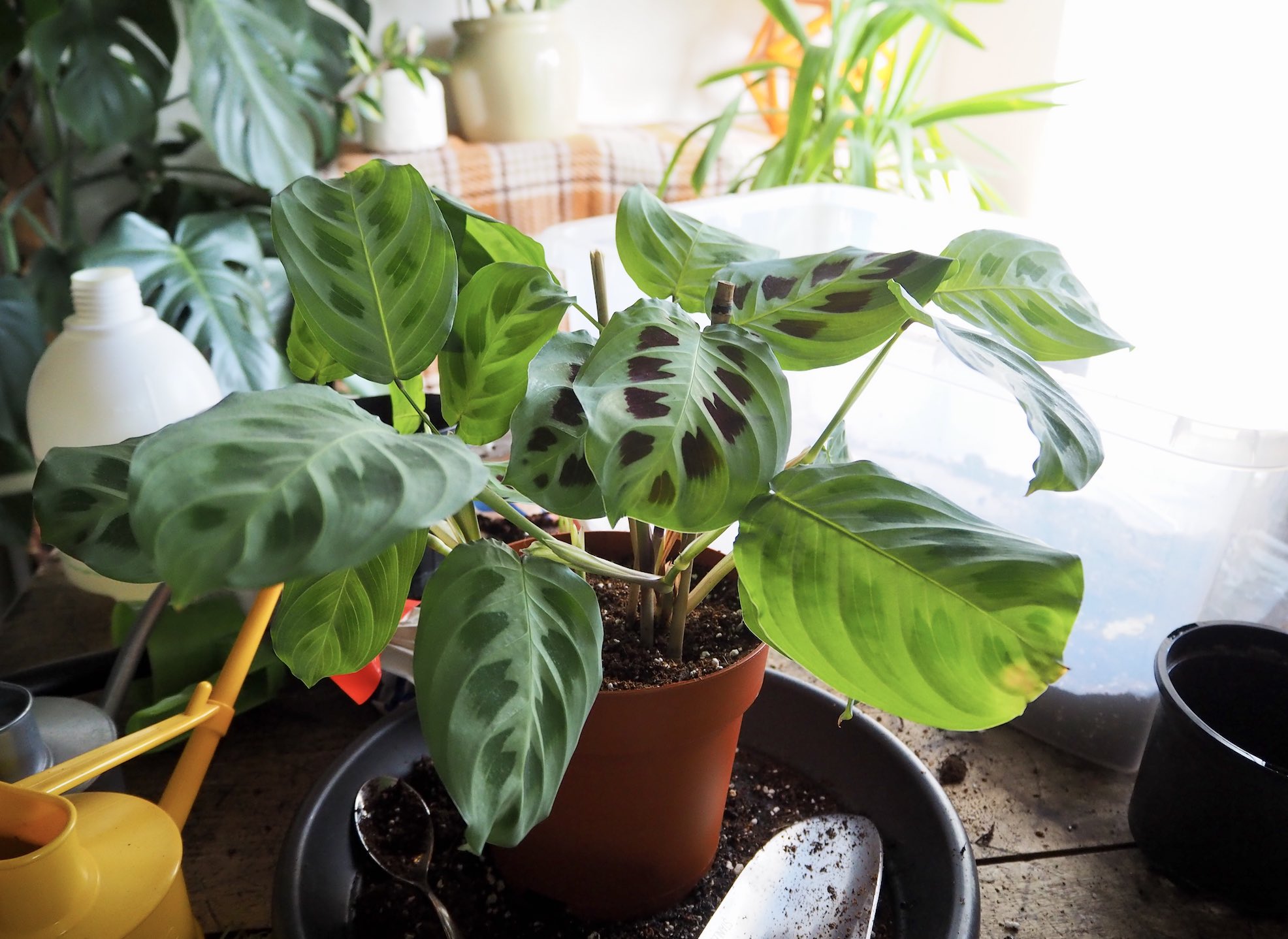

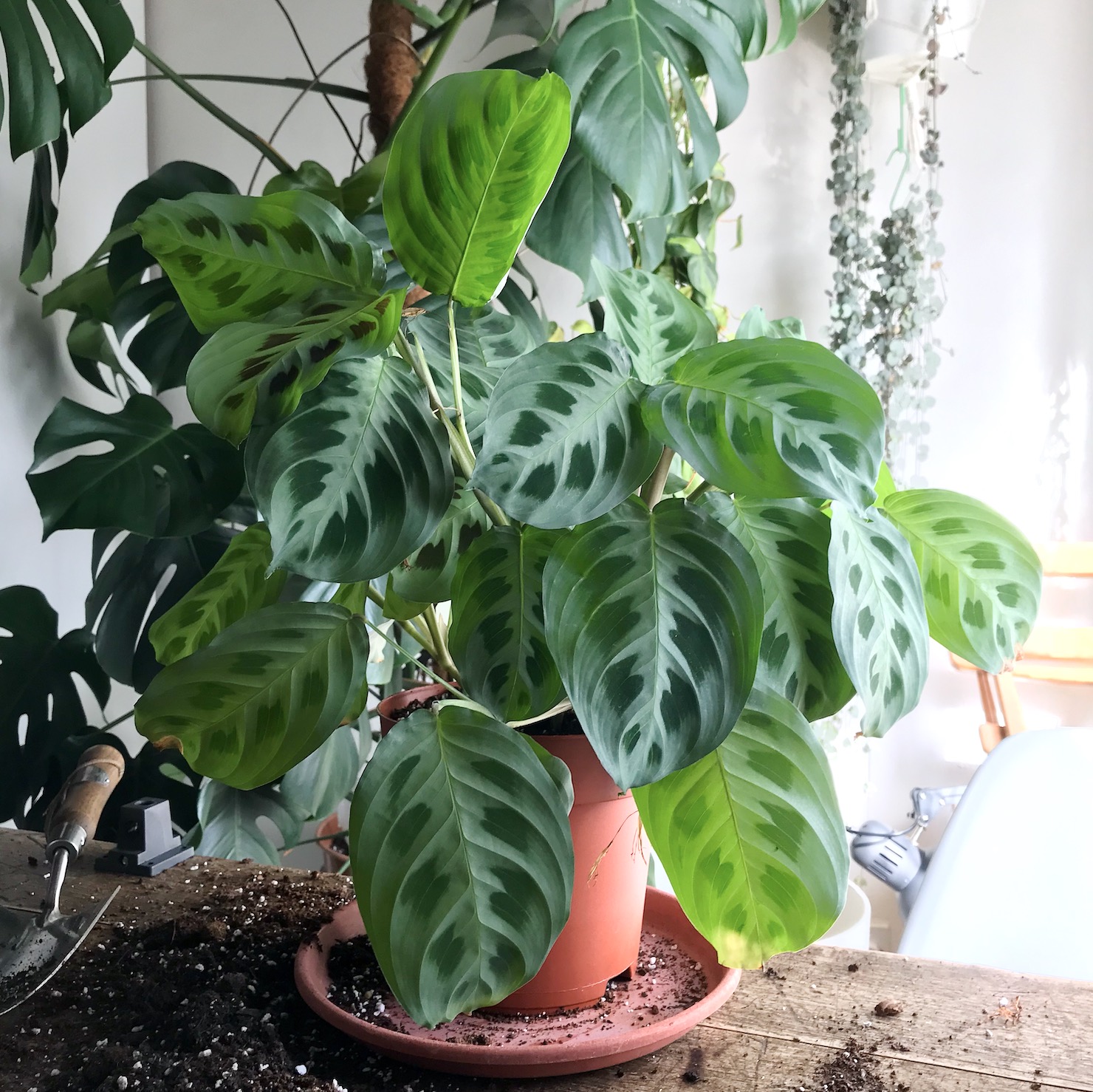
POTTING MIX
In terms of potting mix, I use my standard mix I like to make up of houseplant compost, orchid bark, horticultural grit and some perlite as the base. But in this instance, I’ll add in some extra houseplant compost to allow the potting mix to hold onto moisture for longer. In addition, I will add in some sphagnum moss if I have it. I also like to use it as a pot topper for some extra moisture retention and to keep the soil temperature up too. This is also a good tip if you are prone to under-watering! If you are using this substrate please make sure you buy your Sphagnum from a reputable source.
A NOTE ON POTS:
The type of pot you choose to use is also intrinsically connected to your mix and watering requirements. For me, I prefer to use nursery pots with my prayer plants. As with other humidity loving houseplants, I find they dry out far too quickly in terracotta. Terracotta is much more porous and will wick the moisture away from the plant. If you want to use terracotta for display or plant styling reasons, you can always use the terracotta as a cover (cache) pot.
PROPAGATION
One reason you might find yourself considering propagating your Maranta leuconeura is that the growth has become very dense. I like to prune my plant to help keep this area less compact and to allow air flow around the base.
When propagating by division, it helps to choose a part of the plant that is healthy and that also has some roots. This makes the transition smoother and less stressful for your plant as it adapts to its new home/pot. I’ve got a section about the propagation by division process in the post linked here.


CONCLUSION
I hope you enjoyed reading a bit more about Maranta leuconeura in this care guide.
To refer back to it, you can find it under my ‘Plant Care Guides’ tab on my homepage. I’ll link a few related posts here you might enjoy:
- Then and Now: an update on some of my houseplant propagation projects
- Post-winter plant pep up: helping your houseplants to look their best
- Getting your houseplants ready for Spring
- A HPH guide to… Low light tolerant houseplants
Here are some pins to share or save too:
*Affiliate links are used in the post which means I can receive a (very) small amount of commission if you make a purchase — thank you for supporting my blog. I often get asked where I get specific items from so have linked these here. I have bought all these products with my own money.


Leave a Reply